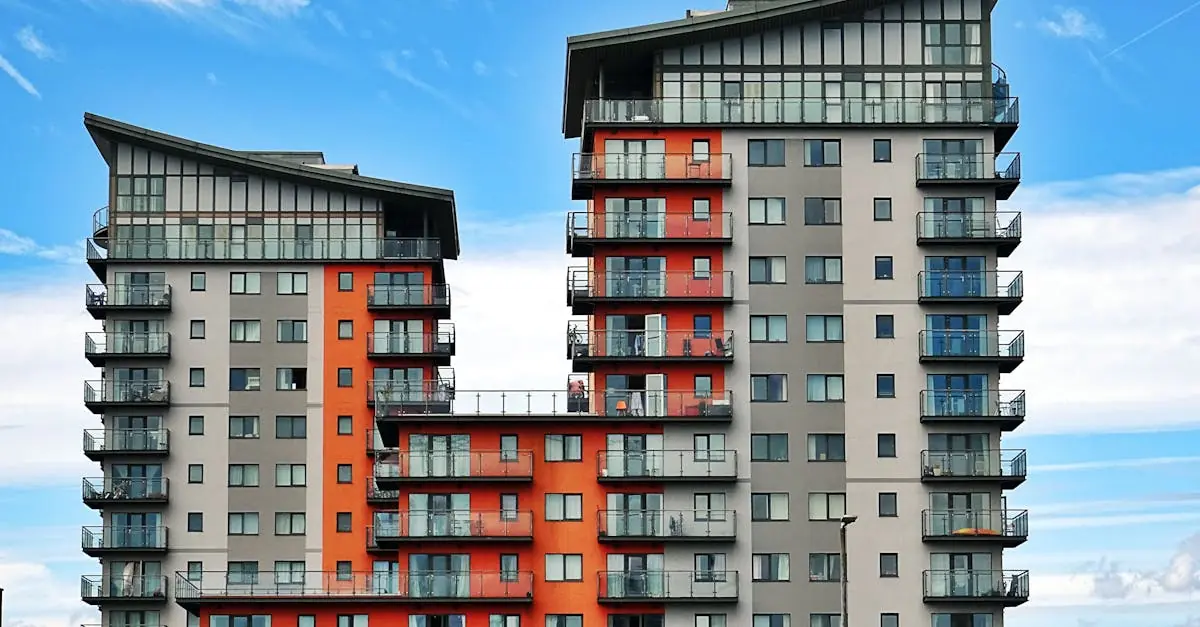In a world where space is at a premium, apartments have become the unsung heroes of modern living. These cozy abodes offer the perfect blend of convenience and style, making them ideal for busy professionals, young families, and anyone who appreciates a good view without the hassle of yard work. Who wouldn’t want to trade a sprawling lawn for a rooftop terrace with a killer sunset?
But let’s be honest—living in an apartment isn’t just about practicality; it’s a lifestyle choice. From quirky layouts to vibrant communities, apartments are like a box of chocolates—you never know what you’re gonna get. Whether it’s a chic studio in the heart of the city or a spacious two-bedroom with a pool, the options are endless. Dive into the world of apartments and discover how they can transform not just your living situation, but your entire life.
Table of Contents
ToggleOverview of Apartments
Apartments serve as versatile living spaces tailored for various lifestyles. Many individuals and families find them appealing due to their compact nature and cost-effectiveness. Most apartments offer essential amenities like security, maintenance, and communal areas, which enhance the living experience.
Diverse layouts cater to different preferences, ranging from studios to multi-bedroom units. Unique designs often create efficient use of space, maximizing both comfort and functionality. Apartment communities typically foster a sense of belonging, encouraging social interaction among residents.
Urban areas frequently feature a high concentration of apartments, making them accessible to professionals and families alike. Locations near public transport and local attractions increase convenience for daily commutes and leisure activities.
Many apartment complexes include fitness centers, swimming pools, and outdoor spaces, which promote an active lifestyle. Outdoor amenities provide resident options for relaxation and recreation without leaving the premises.
Renting an apartment allows for flexibility, appealing to younger demographics and those in transition. Shorter lease terms give residents the chance to relocate as needed, aligning with changes in personal or professional circumstances.
Additionally, the rise of co-living spaces reflects a shift in how individuals approach shared living environments. These spaces often blend private living areas with shared kitchens and lounges, fostering collaboration and community engagement among tenants.
Overall, apartments represent a modern solution to urban dwelling that caters to the needs of today’s society, ensuring convenience and connection among diverse residents.
Types of Apartments
Apartments come in various forms, each designed to meet the unique needs of residents. Understanding the different types can help individuals and families find their ideal living space.
Studio Apartments
Studio apartments feature an open floor plan, combining living, sleeping, and kitchen areas into one cohesive space. These compact units offer efficient design, making them ideal for young professionals and students. With minimal square footage, studio apartments often come with lower rent compared to larger options. Residents appreciate the simplicity, as they can personalize their space with effective organization and decor. Such apartments promote a cozy atmosphere, making it easier to cultivate a sense of home within a limited area.
One-Bedroom Apartments
One-bedroom apartments consist of a separate bedroom, providing added privacy compared to studio formats. Individuals or couples benefit from designated sleeping and living areas, enhancing comfort and functionality. Typically, these units contain a larger kitchen and often include a dining space, accommodating home-cooked meals and entertaining guests. Rent prices vary, generally being more affordable than larger apartments while offering a balanced living experience. Many community features, such as gyms or pools, are accessible, fostering an active lifestyle within convenient reach.
Two-Bedroom Apartments
Two-bedroom apartments cater to small families or individuals who desire extra space. These units usually present two separate bedrooms alongside a shared living area and kitchen. Flexibility is a notable advantage, as residents can use the additional room for guests, a home office, or a child’s space. Rent costs reflect the extra square footage but often remain manageable within many budgets. With shared amenities like laundry facilities or outdoor areas, two-bedroom apartments promote both convenience and community engagement, enhancing the living experience for families and roommates.
Factors to Consider When Renting an Apartment
Renting an apartment involves multiple key considerations that can significantly impact the living experience. Among these, location and amenities play pivotal roles.
Location
Location holds immense importance. Proximity to work, schools, and essential services affects daily convenience. Many look for apartments near public transportation for easier commutes. Urban areas often boast better access to restaurants, shopping, and recreational activities. Safety is another major factor, as crime rates can vary widely between neighborhoods. Additionally, consider future developments that may influence property values and local amenities. Choosing a location aligned with lifestyle needs maximizes satisfaction.
Amenities
Amenities enhance the apartment living experience. Most apartment complexes offer fitness centers for active lifestyles. Swimming pools provide relaxation during hot months. On-site maintenance services simplify home upkeep. Security features like gated access ensure peace of mind. Common areas such as lounges or gardens foster community interaction. When evaluating an apartment, it’s crucial to identify which amenities are essential. These features can greatly influence the overall quality of life and enjoyment within the living space.
The Apartment Hunting Process
Finding the right apartment involves several strategic steps. Organizing the process helps streamline the search, leading to informed decisions.
Online Search Tips
Utilizing online resources accelerates the apartment hunting journey. Websites such as Zillow and Apartments.com provide extensive listings based on specific criteria. Setting filters like price, location, and amenities narrows options effectively. Prioritizing location ensures close proximity to work or schools, enhancing convenience. Using online maps to visualize commute times adds context to various listings. Saving favorite apartments allows easy comparison later, simplifying decision-making. Engaging with user reviews can provide insight into community experiences, supporting informed choices.
Viewing and Inspection
Scheduling viewings enables potential renters to assess apartments firsthand. Attending open houses or arranging private showings helps visualize living spaces. Bringing along a checklist can ensure critical features are evaluated effectively. Inspecting the overall condition of appliances and fixtures is vital for future maintenance expectations. Observing the neighborhood atmosphere adds clarity on community dynamics. Taking photos during visits aids memory recall when comparing options later. Engaging with current residents during visits may reveal valuable insights about apartment life.
Financial Aspects of Renting an Apartment
Understanding the financial obligations associated with renting an apartment is crucial for making informed decisions. Both immediate and long-term costs influence rental choices.
Rent vs. Buy
Renting provides flexibility and lower upfront costs compared to buying. Monthly rent amounts typically range from $1,000 to $3,000, depending on location and size. Buyers face substantial expenses like down payments, which can exceed 20% of the property price, along with mortgage payments and property taxes. Reviewing local housing markets often highlights that renters avoid repairs and maintenance typically borne by homeowners.
Additional Costs
Renting an apartment involves various additional expenses that renters must consider. Security deposits usually equal one month’s rent, while application fees range from $50 to $200. Renters might also encounter utility costs not covered by the lease, including electricity, water, and internet. Moving expenses contribute to overall costs, especially when considering truck rentals or movers. Renters should budget for renters’ insurance, averaging $15 per month, to protect personal belongings. Overall, understanding these factors helps maintain financial stability when renting an apartment.
Apartment living offers a unique blend of convenience and community that resonates with many individuals and families today. With diverse layouts and essential amenities, apartments cater to various lifestyles while promoting a sense of belonging among residents.
The flexibility of renting allows for adaptability in an ever-changing world, making it an attractive option for those navigating personal and professional transitions. As urban areas continue to evolve, the appeal of apartments remains strong, providing not just a place to live but a vibrant lifestyle enriched by shared experiences and modern conveniences.
Exploring the right apartment can significantly enhance one’s quality of life, making it a worthwhile endeavor for anyone considering this living arrangement.



